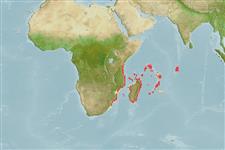Environment: milieu / climate zone / depth range / distribution range
Ökologie
seewasser riff-verbunden; tiefenbereich 3 - 62 m (Ref. 9710), usually ? - 10 m (Ref. 5222). Tropical; 3°S - 31°S, 30°E - 75°E (Ref. 5222)
Western Indian Ocean: Kenya to South Africa, Comoros, Madagascar, Aldabra, Seychelles, Mauritius, St. Brandon's Shoals, Nazareth Bank, and the Chagos Archipelago. Unknown from the Red Sea, Persian Gulf, and the Asian coast from Arabia to India.
Size / Gewicht / Alter
Maturity: Lm ? range ? - ? cm
Max length : 96.0 cm TL Männchen/unbestimmt; (Ref. 4787); max. veröff. Gewicht: 17.3 kg (Ref. 92920)
Rückenflossenstacheln (insgesamt) : 7 - 8; Rückenflossenweichstrahlen (insgesamt) : 10 - 12; Afterflossenstacheln: 3; Afterflossenweichstrahlen: 8.
Usually found in shallow water (less than 10 m), however, Kyushin et al. (1977, Ref. 6894) reported specimens caught on a vertical longline at depths of 45 to 62 m. Solitary or in small groups. Often drifts well above the bottom (Ref. 9710). Feeds exclusively on fishes (parrotfishes, wrasses, holocentrids, acanthurids, a triggerfish, and a juvenile Sphyraena) (Ref. 6448). Also caught with trawls.
Life cycle and mating behavior
Maturities | Fortpflanzung | Spawnings | Egg(s) | Fecundities | Larven
Heemstra, P.C. and J.E. Randall, 1993. FAO Species Catalogue. Vol. 16. Groupers of the world (family Serranidae, subfamily Epinephelinae). An annotated and illustrated catalogue of the grouper, rockcod, hind, coral grouper and lyretail species known to date. Rome: FAO. FAO Fish. Synop. 125(16):382 p. (Ref. 5222)
IUCN Rote Liste Status (Ref. 130435)
Bedrohung für Menschen
Harmless
Nutzung durch Menschen
Fischereien: kommerziell
Tools
Zusatzinformationen
Download XML
Internet Quellen
Estimates based on models
Preferred temperature (Ref.
123201): 25 - 28.1, mean 27.1 °C (based on 268 cells).
Phylogenetic diversity index (Ref.
82804): PD
50 = 0.5078 [Uniqueness, from 0.5 = low to 2.0 = high].
Bayesian length-weight: a=0.01148 (0.00558 - 0.02364), b=3.04 (2.88 - 3.20), in cm total length, based on LWR estimates for this (Sub)family-body shape (Ref.
93245).
Trophic level (Ref.
69278): 4.5 ±0.79 se; based on food items.
Widerstandsfähigkeit (Ref.
120179): niedrig, Verdopplung der Population dauert 4,5 - 14 Jahre. (Preliminary K or Fecundity.).
Fishing Vulnerability (Ref.
59153): High vulnerability (58 of 100).
Nutrients (Ref.
124155): Calcium = 21.7 [13.4, 37.4] mg/100g; Iron = 0.457 [0.248, 0.770] mg/100g; Protein = 18.7 [16.9, 20.4] %; Omega3 = 0.135 [0.089, 0.206] g/100g; Selenium = 38.4 [21.4, 71.4] μg/100g; VitaminA = 116 [40, 376] μg/100g; Zinc = 0.746 [0.516, 1.057] mg/100g (wet weight);
